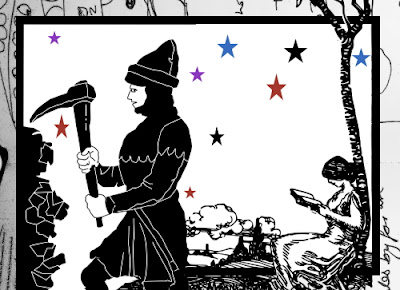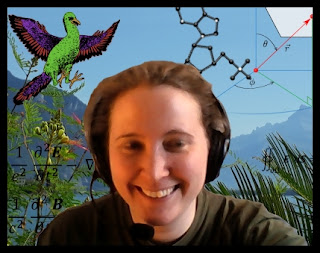Brandon Sanderson, Douglas Adams and Mining the Seam
Good Morning and Greetings!
Today’s post is mainly about books, creativity and burn-out.
I was recently introduced to the work of Brandon Sanderson or- more
specifically- his novel “Skyward” , which is all shades of awesome and very
highly recommended.
Anyway, I love finding a new artist/writer who is already part way
through their career -because it is like finding a seam of coal/books/albums
fresh to mine, one by one, instead of having to sit and wait for a year or two
between instalments of their work. With Harry Potter, I came to the series
about the time J.K.Rowling was writing book 3 or 4, so I had both the
experience of finding a new “seam-of-creativity” and then the period of waiting
to find out what was going to happen next, instalment by instalment (and the endless
discussions with others about what we thought would happen). This whole
discover-a-new-artist-and-their-creative-“seam” thing usually happens to me
with musicians, rather than writers (Paul Simon was one, then Ed Sheeran and,
more recently, Melissa Ferrick- all highly recommended, by the way) , but
Brandon Sanderson is a real find. It almost takes me back to “discovering”
Douglas Adams, Terry Pratchett and David Sedaris all over again. Not only that,
but Sanderson is famously prolific, so the lull between books promises not to
be too long*.
So, in the little time I have known of Mr Sanderson’s existence, I
have learnt a few things about him. A list would not be particularly
worthwhile, but most interesting I think is that he writes an annual “State of
the Sanderson”/ “State of the Nation” post each year on his birthday, outlining
his writing plans for the year ahead**. Now, most of the writers I know tell me
that they are juggling multiple competing projects at any one time and that
certainly applies to me. The last thing I would want to do in the run up to my
birthday is draft and articulate a plan of exactly what I intend to do. I am
not sure I could even do so if I tried- so much of this kind of work depends
upon factors outside of the writer’s conscious control.
There is a general plan- yes- half a dozen projects that seem
exciting. I currently seem to have 2 main books on the go most of the time,
with a raft of smaller pieces that get fitted in around them. The smaller
pieces are mostly magazine items, some blog posts and some technical paper
editing. Yet sometimes a year goes by and one project makes no progress at all.
Othertimes something is done and dusted in 31days flat. It is not all a matter
of hours put in to a project, either- just sometimes things gel and sometimes
they don’t.
The thing is, the more people I talk to in this line of work, the
more I realise that is a pretty typical experience. Academic writing and
academic writers are a bit different, it seems- perhaps a bit more structured.
From experience, it probably helps that academics are encouraged to write in
great detail on a fairly narrow array of subjects. They are encouraged to be
“deep and narrow”, rather than “broad and wide”. Commercial writers, on the
other hand, generally seem to have a lot of somewhat disparate stuff going on
at any one time and editors, often even more so.
This mode of working can be a great relief, as well as and an
economic necessity. For example, one of the two books I am working on delves
both into a lot of technical material and into a lot of esoteric subjects. The
source material ranges from terse and seemingly reliable military accounts to
badly translated and rambling testimony from the strangest, most motley array
of witnesses you could ask for. A little while back, I got to the point where
it was just making my head hurt and I had to take a break. So I did.
Ultimately, while “book 1” has been on hiatus, I have written the
better part of 2 popular science magazines, single handed, commissioned and
edited almost all of the remaining content for them, done a sheaf of anonymous
editing (ghost editing) of technical articles, written the posts on here and
done about 35 to 40% of another book I started years earlier. None of that was
really planned. Or, at least, the sequence of events was not.
In a lot of ways, this break has been really quite productive. “Book
2” is currently in full flow, so that will end up being completed before “Book
1”. That altered sequence is fine, even if it is not how any of this was
planned. The point being that experiences and work patterns like that seem to
be fairly typical for most writers. So I would venture that someone who is able
to plan as well as Mr Sanderson is not “your typical writer” in his methods;
kudos to him. Whatever he does, if “Skyward” is typical, he does it very well.
That’s all from me for today. Thanks for reading and see you next
time.
Victoria
Footnotes.
* Although Douglas Adams is one of my all-time favourite writers, he
was well known for be unprolific and perennially beset with writer’s block. If
accounts by those who knew him are accurate, he used to take lengthy baths,
send product-improvement suggestions to Apple Computers and have long gossiping
sessions with friends to fill in the long periods between bouts of productive
writing. I get the firm impression that he would have been a great fun friend,
but, sadly, none of that helped to expand the Hitchhiker or Dirk Gently series
at anything beyond a snail’s pace.
** Thanks to Nurit for supplying that information and introducing me
to all of that jazz…


Ooh, Brandon Sanderson! You should check out his Mistborn trilogy, it start out like a magical Ocean's 11 and just goes wild from thete.
ReplyDelete